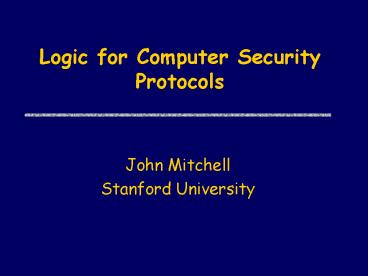Logic for Computer Security Protocols PowerPoint PPT Presentation
1 / 21
Title: Logic for Computer Security Protocols
1
Logic for Computer Security Protocols
- John Mitchell
- Stanford University
2
Revised course schedule
- Tuesday, Mar 4 - Lecture
- Thursday, Mar 6 No class
- Work on project, rest up for Mar 11
- Tuesday, Mar 11 Longer meeting
- Present 6 out of 10 projects
- Meet 215 415 (subject to approval)
- Thursday, Mar 13 Last class
- Present remaining projects
3
Outline
- Example
- Floyd-Hoare logic of programs
- BAN logic
- Current Protocol Logic
4
Part I
- Logic of programs
- Historical references
- Floyd,
- Hoare,
5
Before-after assertions
- Main idea
- F ltPgt G
- If F is true before executing P, then G after
- Two variants
- Total correctness F P G
- If F before, then P will halt with G
- Partial correctness F P G
- If F before, and if P halts, then G
6
While programs
- Programs
- P x e PP if B then P else P
- while B do P
- where x is any variable
- e is any integer expression
- B is a Boolean expression (true or
false)
7
Assertion about assignment
- Assignment axiom
- F(t) x t F(x)
- Examples
- 77 x 7 x7
- (y1)gt0 x y1 xgt0
- x12 x x1 x2
This is not most general case. Need to assume no
aliasing
8
Rule of consequence
- If
- F P G
- And
- F ? F and G ? G
- Then
- F P G
9
Example
- Assertion
- ygt0 x y1 xgt0
- Proof
- (y1)gt0 x y1 xgt0
(assignment axiom) - ygt0 x y1 xgt0
(consequence) - Assertion
- x1 x x1 x2
- Proof
- x12 x x1 x2 (assignment
axiom) - x1 x x1 x2
(consequence)
10
Conditional
- F ? B P1 G
- F ??B P2 G
- F if B then P1 else P2 G
- Example
- true if y ? 0 then x y else x -y
x ? 0
11
Sequence
- F P1 G
- G P2 H
- F P1 P2 H
- Example
- x0 x x1 x x1 x2
12
Loop Invariant
- F ? B P F
- F while B do P F ??B
- Example
- true while x ? 0 do x x-1 x0
13
Example Compute dx-y
P0
B
P1
- Assertion
- y?x d0 while (yd)ltx do d d1
ydx - Main ideas in proof
- Choose loop invariant yd?x
- yd?x ? B P1 yd?x
- yd?x while B do P1 yd?x ??B
- Use assignment axiom and sequence rule to
complete the proof of property of P1
14
Facts about Hoare logic
- Compositional
- Proof follows structure of program
- Sound
- Provable statement are true !
- Relative completeness
- Properties of computation over N provable from
properties of N - Some technical issues
- Important concept Loop invariant !!!
- Common practice beyond Hoare logic
15
Part II
- BAN Logic
16
There is something called BAN
- Needham
- The main contribution of BAN logic was to make
the study of 3-line protocols intellectually
respectable. - Paper,
- A Logic of Authentication", ACM Transactions on
Computer Systems, Vol. 8, No. 1, pp. 18-36,
February 1990.
17
Using BAN Logic
- Protocol expressed in idealized form
- Identify initial assumptions in the language of
BAN logic - Use postulates and rules of BAN logic to deduce
new predicate
18
Notation
- P ?X P believes X
- P would be entitled to believe X.
- The principal P may act as though X is true.
- P ?X P sees X
- P can read the contents of X (possibly after
decryption, assuming P has the needed keys) - P can include X in messages to other principals
19
BAN Logic
- P X P once said X
- P sent a message including the statement X.
- Possibly in the past or in the current run of the
protocol - P believed that X was true when it send the
message - P ? X P controls X
- P has jurisdiction over X
- P is a trusted authority on the truth of X.
- (X) X is fresh
- The present begins with the start of the current
execution of the current protocol - X is fresh if it is not contained in any message
in the past
20
BAN Logic
- K
- P ? Q K is a shared key for P and Q.
- K is a secure key for communication between P and
Q - K will never be discovered by any principal
except for P or Q, or a principal trusted by
either P or Q. - K
- ? P K is a public key for P
- The matching secret key (the inverse of K,
denoted by K-1) will never be discovered by any
principal except P, or a principals trusted by P
21
BAN Summary
- Contributions
- A formal language for talking about protocol
properties - A deduction system for deriving some properties
from others - Drawbacks
- Need to translate protocol into simple
properties in order to prove complex ones - No direct connection between BAN properties and
execution of protocol

